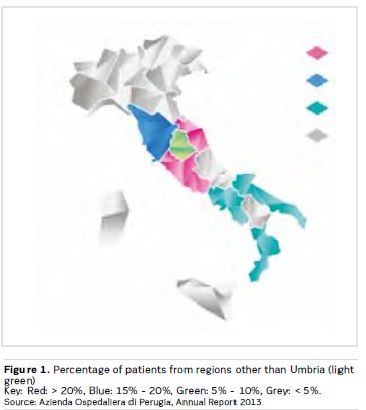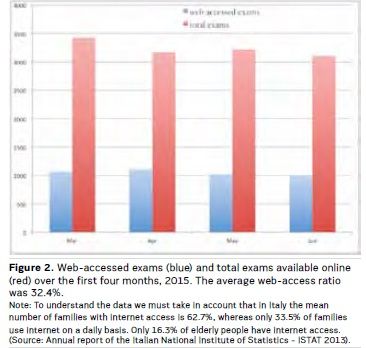HealthManagement, Volume 15 - Issue 3, 2015
Dr. Roberto Tarducci, Chief of the Medical Physics Dept, Santa Maria della Misericordia- Azienda Ospedaliera di Perugia, shares his thoughts on the progress of their project to enable remote patient access to their diagnostic data. This project is just the latest stage in its transformation of access to and storage of images from its radiology and nuclear medicine services, with the aim of enhancing patient care.
Background
Santa Maria della Misericordia hospital in Perugia, Italy is the largest hospital in the region of Umbria (population 894,762 in 2015), serving residents from within and outside the region (see Figure 1). The hospital has more than 800 beds, and 41,160 patients were hospitalised in 2013. It is a reference centre for the region of Umbria as well as for adjacent regions. It is designated as a Highly Specialized Enterprise (Azienda di Alta Specialità), due to its high level of technology and the specialised professional staff who work there.


Since 2000 the Hospital has used an Agfa HealthCare Patient Archiving and Communication System (PACS) and Radiology Information System (RIS) to optimise the efficient operation of its imaging services. Already in 2006 access to imaging performed by both the Radiology and Nuclear Medicine Departments was made available to all clinical departments in the hospital.
In August 2014 the Azienda Ospedaliera di Perugia and Agfa HealthCare signed an agreement to implement a data centre, including a cloud solution. This solution will make it possible to store data – images, reports, diagnostic results, ECG – from the various hospital departments in the cloud, with a high level of data privacy and security. At the same time, the Azienda Ospedaliera di Perugia decided to implement a patient portal, thus allowing patients access to their images and data, with the same high levels of data privacy and security.
Patient Access to Images
After opening up access across the hospital, the logical next step was to initiate access to allow patients access to their images. On March 1, 2015 Azienda Ospedaliera di Perugia activated this service, allowing patients remote access to their diagnostic data.
Why did you decide to enable patient access to their imaging information?
We set out to make diagnostic results available to patients via the internet for several reasons. Patients are used to convenient access to information over the internet in their daily life, and we believe that medicine should not be any different. There are many benefits of making results accessible to patients. Accessing their own diagnostic results is more convenient for patients and their families in terms of time, and it also guards against possible loss of private data by other methods, for example in hard copy such as DVDs, which may be lost and/or get into the wrong hands. Visualisation is possible using numerous devices, and, not least, this method is environmentally friendly, because we are not using resources to burn and distribute DVDs with images.

Why did you choose the Agfa HealthCare solution? What did you see as the advantages?
We chose Agfa HealthCare as our partner for RIS/PACS and hospital image distribution, because we found the solution to be both reliable and userfriendly. The main advantage is that Agfa HealthCare provides us with excellent integration among our different departments.
What were the main challenges?
The principal challenges included guaranteeing the safe storage of data, and protecting against any possible risk of data theft. Another key concern was to promote acceptance by hospital personnel of this change in their work practices. It was important to involve them in the decision- making process.
What was the first step in implementation?
The first step in implementation was to instruct patients on the convenience in using this new service. Specifically, access is much simpler and loss of documents is no longer a risk.
How did you inform patients about the imaging portal? How can patients access the portal?
There were some articles in the local press, which included some practical examples of cases. Also, at the end of each diagnostic test, patients are made aware of the possibility that they can obtain their test results directly from their personal devices.

Is mobile access an advantage? Has the portal increased patient engagement?
Mobile access is available to our patients, and it is highly appreciated.Patients express their appreciation of the fact that their data has been made more accessible, which suggests that this change has allowed them to feel more involved in the medical process. For patients who are accustomed to daily use of the internet the portal is more friendly than the classic system comprising paper report and DVDs. For older patients, or those less accustomed to use of the internet, online access is a great effort and they normally prefer the traditional method.
Have you quantified the return on investment (ROI)? For example, the time and money saved by not burning and posting CDs and DVDs, or any other measures?
We have calculated a 10% annual financial savings in terms of spending on the production of CDs and DVDs. Likewise, the number of patients returning to the hospital to pick up their test results has declined, suggesting that they are also saving time and money.
You anticipated a significant impact on emergency care. Have these been realised through having immediate access to patient’s previous imaging?
The hospital of Perugia has the largest emergency structure in the region and the RIS/PACS/imaging distribution is set up very well: the data of radiological emergency patients are immediately available within the hospital.
What are the next steps and future plans?
We would like to do the following:
• Render the complete imaging archive accessible to patients; currently only the latest exams are available for consulting;
• Extend the service to the other hospitals throughout the region of Umbria. This project has been t he model to integrate data centres from other hospital sites in the region;
• Make instant messaging available to remind patients of future appointments.


